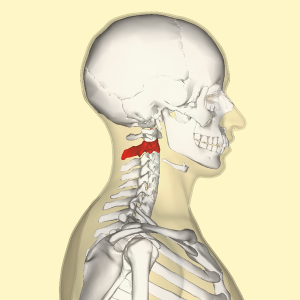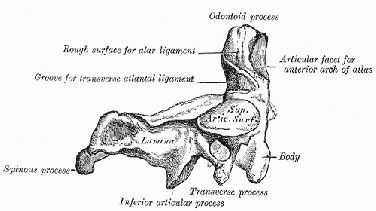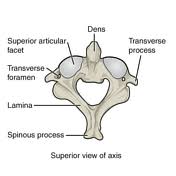Axis: Difference between revisions
(Created page with "== Introduction == The Axis forms the pivot upon which the first cervical vertebra (the Atlas), which carries the head, rotates. ==Structure== ===Odontoid process=== The...") |
Kim Jackson (talk | contribs) m (Text replacement - "Category:Anatomy - Cervical Spine" to "") |
||
| (27 intermediate revisions by 5 users not shown) | |||
| Line 1: | Line 1: | ||
= | <div class="editorbox"> | ||
'''Original Editor '''- [[User:Rachael Lowe|Rachael Lowe]] | |||
'''Top Contributors''' - {{Special:Contributors/{{FULLPAGENAME}}}} | |||
</div> | |||
== Introduction == | |||
[[Image:C2 lateral.png|thumb|center]] The Axis (C2 vertebra) also known as epistropheus forms the pivot upon which the first cervical vertebra (the [[Atlas]]), which carries the head, rotates.<ref>Axis (anatomy) - Wikiwand /www.wikiwand.com/en/Axis_(anatomy) (accessed 26 June 2018)</ref> The axis is composed of a vertebral body, heavy pedicles, laminae, and transverse processes, which serve as attachment points for muscles. The axis articulates with the atlas via its superior articular facets, which are convex and face upward and outward. | |||
== | == Structure == | ||
[[File:AXIS VERTEBRA.gif|left|thumb|'''Lateral view'''|376x376px]] | |||
[[File:Axis v.jpg|center|thumb| '''Posterosuperior view''']] | |||
===Vertebral body=== | === Odontoid process === | ||
The most distinctive characteristic of this bone is the strong [[Odontoid process|Odontoid Process]](also known as the "dens") which rises perpendicularly from the upper surface of the body.It is a prominent rounded superior projection from the body.This tooth-like elevation serves a stable point around which the atlas bone rotates. Posteriorly the Odontoid process is flattened where it articulates with the transverse ligament.<ref>Cervical Spine Anatomy: Overview, Gross Anatomy https://emedicine.medscape.com/article/1948797-overview#a2 (accessed 26 June 2018)</ref> | |||
=== Vertebral body === | |||
The body is deeper in front than behind, and prolonged downward anteriorly so as to overlap the upper and front part of the third vertebra. It presents in front a median longitudinal ridge, separating two lateral depressions for the attachment of the Longus colli muscles. Its under surface is concave from before backward and convex from side to side. | The body is deeper in front than behind, and prolonged downward anteriorly so as to overlap the upper and front part of the third vertebra. It presents in front a median longitudinal ridge, separating two lateral depressions for the attachment of the Longus colli muscles. Its under surface is concave from before backward and convex from side to side. | ||
===Other Structures=== | === Other Structures === | ||
The '''pedicles''' are broad and strong, especially in front, where they coalesce with the sides of the body and the root of the odontoid process. They are covered above by the superior articular surfaces. | |||
The '''laminae''' are thick and strong, and the vertebral foramen large, but smaller than that of the atlas. | |||
The | The '''transverse processes''' are very small, and each ends in a single tubercle; each is perforated by the transverse foramen, which is directed obliquely upward and laterally. | ||
The | The '''superior articular facets''' are round, slightly convex, directed upward and laterally,It articulates with the inferior articular facet on the altas bone above (C1) to form the atlantoaxial joint. | ||
The transverse | The '''inferior articular facets''' lies posterior to the transverse process and is directed downwards and forwards to articulate with the third cervical vertebra. | ||
The superior | The '''superior vertebral notches''' are very shallow, and lie behind the articular processes; the inferior lie in front of the articular processes, as in the other cervical vertebrae. | ||
The | The '''spinous process''' is large, very strong, deeply channelled on its under surface, and bifid.<ref name=":0">B D Chaurasia's Human Anatomy Regional and Applied Dissection and Clinical Volume 3 Head, Neck and Brain Fourth edition CBS Publishers and distributors</ref> | ||
The | === Attachments === | ||
* The odontoid process provides attachment at its apex to the apical ligament and on each side below the apex to the alar ligaments.<ref name=":0" /> | |||
* The transverse processes serve as the attachment sites of muscles that assist in rotating the head.They are levator scapulae , the sclenus medius anteriorly and the splenius cervicis posteriorly. | |||
* The foramina (the holes) give passage to the vertebral artery and vertebral vein. | |||
* The spinous process serves as the attachment site for many muscles of the spine, particularly those close to the skull, as well as the nuchal ligament. The muscles are semisplinalis servicis ,the rectus capitis posterior major,the inferior oblique, the spinalis cervicis , the interspinalis and the multifidus. | |||
* The lamina provides attachment to the ligamentum flava. | |||
=== Clinical significance === | |||
* [[Odontoid fractures]] | |||
* The condition, where the dens is separated from the body of the axis, is called '''os odontoideum''', and may cause nerve and circulation compression syndrome. | |||
== References == | |||
[[Category:Cervical Spine - Anatomy]] [[Category:Bones]] [[Category:Cervical Spine - Bones]] [[Category:Cervical Spine]] | |||
Latest revision as of 13:40, 23 August 2019
Original Editor - Rachael Lowe
Top Contributors - Mandeepa Kumawat, Admin, Kim Jackson, George Prudden and WikiSysop
Introduction[edit | edit source]
The Axis (C2 vertebra) also known as epistropheus forms the pivot upon which the first cervical vertebra (the Atlas), which carries the head, rotates.[1] The axis is composed of a vertebral body, heavy pedicles, laminae, and transverse processes, which serve as attachment points for muscles. The axis articulates with the atlas via its superior articular facets, which are convex and face upward and outward.
Structure[edit | edit source]
Odontoid process[edit | edit source]
The most distinctive characteristic of this bone is the strong Odontoid Process(also known as the "dens") which rises perpendicularly from the upper surface of the body.It is a prominent rounded superior projection from the body.This tooth-like elevation serves a stable point around which the atlas bone rotates. Posteriorly the Odontoid process is flattened where it articulates with the transverse ligament.[2]
Vertebral body[edit | edit source]
The body is deeper in front than behind, and prolonged downward anteriorly so as to overlap the upper and front part of the third vertebra. It presents in front a median longitudinal ridge, separating two lateral depressions for the attachment of the Longus colli muscles. Its under surface is concave from before backward and convex from side to side.
Other Structures[edit | edit source]
The pedicles are broad and strong, especially in front, where they coalesce with the sides of the body and the root of the odontoid process. They are covered above by the superior articular surfaces.
The laminae are thick and strong, and the vertebral foramen large, but smaller than that of the atlas.
The transverse processes are very small, and each ends in a single tubercle; each is perforated by the transverse foramen, which is directed obliquely upward and laterally.
The superior articular facets are round, slightly convex, directed upward and laterally,It articulates with the inferior articular facet on the altas bone above (C1) to form the atlantoaxial joint.
The inferior articular facets lies posterior to the transverse process and is directed downwards and forwards to articulate with the third cervical vertebra.
The superior vertebral notches are very shallow, and lie behind the articular processes; the inferior lie in front of the articular processes, as in the other cervical vertebrae.
The spinous process is large, very strong, deeply channelled on its under surface, and bifid.[3]
Attachments[edit | edit source]
- The odontoid process provides attachment at its apex to the apical ligament and on each side below the apex to the alar ligaments.[3]
- The transverse processes serve as the attachment sites of muscles that assist in rotating the head.They are levator scapulae , the sclenus medius anteriorly and the splenius cervicis posteriorly.
- The foramina (the holes) give passage to the vertebral artery and vertebral vein.
- The spinous process serves as the attachment site for many muscles of the spine, particularly those close to the skull, as well as the nuchal ligament. The muscles are semisplinalis servicis ,the rectus capitis posterior major,the inferior oblique, the spinalis cervicis , the interspinalis and the multifidus.
- The lamina provides attachment to the ligamentum flava.
Clinical significance[edit | edit source]
- The condition, where the dens is separated from the body of the axis, is called os odontoideum, and may cause nerve and circulation compression syndrome.
References[edit | edit source]
- ↑ Axis (anatomy) - Wikiwand /www.wikiwand.com/en/Axis_(anatomy) (accessed 26 June 2018)
- ↑ Cervical Spine Anatomy: Overview, Gross Anatomy https://emedicine.medscape.com/article/1948797-overview#a2 (accessed 26 June 2018)
- ↑ 3.0 3.1 B D Chaurasia's Human Anatomy Regional and Applied Dissection and Clinical Volume 3 Head, Neck and Brain Fourth edition CBS Publishers and distributors









